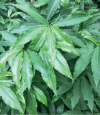Costus afer: A Systematic Review of Evidence-Based Data in support of Its Medicinal Relevance
- PMID: 32082693
- PMCID: PMC7011497
- DOI: 10.1155/2019/3732687
Costus afer: A Systematic Review of Evidence-Based Data in support of Its Medicinal Relevance
Abstract
Costus afer (C. afer) is a plant commonly known as ginger lily, spiral ginger, or bush cane. It is reportedly used in traditional medicine practice (TMP) to treat and manage many ailments including diabetes mellitus, stomach ache, arthritis, inflammation, and gout. These purported ethnomedicinal uses have triggered many research studies on the plant to amass scientific evidence. However, these research reports are scattered, and thus, this systematic review seeks to provide a comprehensive update on it covering its traditional uses, phytochemical and nutritional constituents, pharmacological activities, and toxicological effects. An online search was done using search engines such as Google Scholar, PubMed, and ScienceDirect from the period 1970 to 2019. The online search included the use of keywords, "Costus afer Ker-Gawl" or "Costus afer." The search revealed that the stem and leaves of the plant contain substantial amounts of micronutrients and macronutrients. The leaves, stem, rhizomes, and roots of C. afer contain several steroidal sapogenins, aferosides, dioscin, and paryphyllin C and flavonoid glycoside kaempferol-3-O-α-L-rhamnopyranoside. Experimental studies on various parts of the plant showed bioactivities such as antihyperglycemic, hepatocellular protection, cardioprotection, nephroprotection, testicular protection, CNS depressant, analgesic, antiarthritis, antibacterial, and antioxidant. Based on these evident data, it is concluded that the plant could be used as an alternative and complementary therapy for many oxidative stress-related diseases, provided further scientific studies on the toxicological and pharmacological aspects are carried out.
Copyright © 2019 Daniel Boison et al.
Conflict of interest statement
The authors declare that they have no conflicts of interest.
Figures
References
-
- ThankGod N. K., Monago C. C., Anacletus F. C. Antihyperglycemic activity of the aqueous extract of Costus afer stem alone and in combination with metformin. European Journal of Biotechnology and Bioscience. 2014;1(5):19–25.
-
- Okugbo T., Oriakhi K. A comparative study of in vitro antioxidant activity and phytochemical constituents of methanol extract of aframomum melegueta and Costus afer leaves. Jordan Journal of Biological Sciences. 2015;8(4):273–279. doi: 10.12816/0027063. - DOI
-
- Anyasor G., Onajobi F., Osilesi O., Adebawo O. Hexane fraction of Costus afer Ker Gawl leaf inhibited mitochondrial permeability transition, F1F0 ATPase and scavenged nitric oxide and hydrogen peroxide (957.1) Journal of Investigational Biochemistry. 2014;3(2):p. 79. doi: 10.5455/jib.20140723062605. - DOI
-
- Omokhua G. E. Medicinal and socio-cultural importance of Costus afer (Ker Grawl) in Nigeria. African Research Review. 2011;5(5):282–287. doi: 10.4314/afrrev.v5i5.22. - DOI
Publication types
LinkOut - more resources
Full Text Sources




